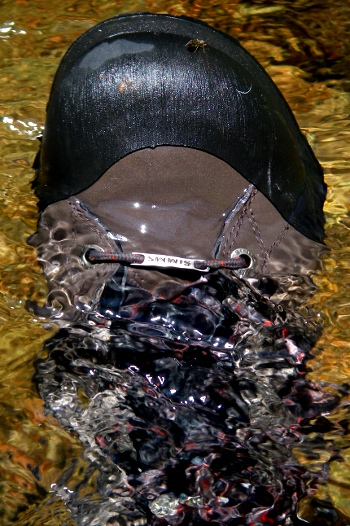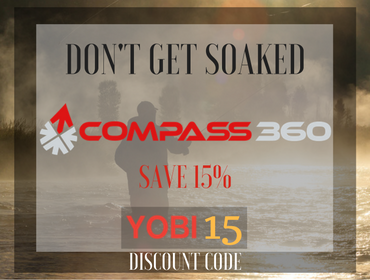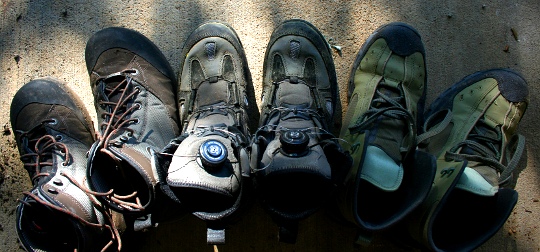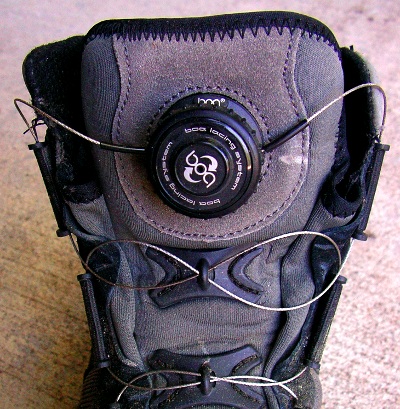fly fishing stuff, fly fishing wading boots, korker wading boots, patagonia wading boots, Review, simms wading boots, wading boot reviews, wading boots
The Underground's Wading Boot Review Begins a New Chapter
By Tom Chandler 7/6/2009
5 minutes
Our ongoing fly fishing wading boot review is about to enter a new chapter - this one written largely in
Montana.

The Underground's
Director of Wading Safety (me) and a handful of
local guides who foolishly picked up the phone when we called, we've tested the
Patagonia Riverwalkers and
Simms Headwater boots a fair amount, and now we're spliciing a new pair of
Korker Guide wading boots (and several pairs of interchangable soles) to the program.
Of course, my original goal wasn't to test the boots themselves as much as the sticky rubber soles - would the latest generation be ready for anything fly fishermen have to throw at them?

The answer - at least as it pertains to the bare rubber soles - is "not quite."
Close, but not quite.
Local guides Wayne Eng and Steve Bertrand liked the new rubber soles in the calmer parts of the Upper Sacramento River, but after a little testing, neither wanted anything to do with the sticky rubber in the McCloud.
I recently fished the McCloud in Patagonia's Riverwalkers, and those sticky rubber soles did well enough that I survived the experience, but I'd probably screw in some studs if I fished the McCloud all the time.
The thinking on the Simms and Riverwalkers were confirmed by comments from readers, some of whom fish a lot.
Simply put, if you're fishing tough waters (the McCloud is a notoriously difficult river to wade, as is the Pit), adding a few screw-in studs to the new sticky rubber soles is probably necessary, and frankly, that's hardly the end of the world.
After all, what you'd end up with is a boot that grips about as well as felt in the tough stuff, grips better in tricky out-of-the-water situations, yet lasts a zillion times longer. (They also don't transmit invasives quite so readily, though I believe the role of felt soles in that transmission is a little overplayed.)
Our Conclusions About Boots (So Far)

I'm going to write a big wrap-up article after Montana, but here are my impressions so far.
Simms Headwater Wading Boot
The headwater is a nice, protective boot (hard rubber toe cap is handy), and obviously, lots of folks love the Simms fit.
Still, I'll be honest; I'm a tiny bit less sanguine about the Simm's hard Vibram sole than I am the softer sole of the Patagonia boots, though I reserve the right to change that thinking if the Riverwalkers wear too quickly.
The Simms vibram sole feels hard and stiff, yet gripped beautifully on the Rogue River's rock-snot, cobble-sized testing grounds (the aggressive tread pattern might have something to do wtih that).
On the bigger, angular rocks of the McCloud, the Simms rubber soles were less thrilling, though there's ample testimony from readers that a few metal studs (screw 'em in yourself) would largely fix that issue.
I do believe the Simms Vibram soles would last a long, long time.
Patagonia Riverwalkers
I've already extensively reported on the Riverwalkers, and since that report, I'm happy to say I've reinforced my original thinking.
The Riverwalkers are the best choice for the blueliner; they're extremely comfortable on the trail and the very soft, very sticky rubber works beautifully in the small stream environment.
On a small, bouldered local freestone stream, I could practically walk up the side of dry boulders - a handy feature as fly fishing small freestoners is half rock climbing anyway.
The Riverwalkers are flexible, light, go on easy, and just generally make my feet happy. They hike beautifully.
My brain was less thrilled when I wore them on a recent outing to the McCloud, where I was trying awfully hard to catch a fish for a TV crew (and failing).
The sticky rubber sole worked fairly well, but the failure mode was bad - they gripped the McCloud's very hard-to-wade rocks until they didn't - and the sudden loss of grip was... ahh... unpleasant.
I'll be blunt: the Riverwalker's bare rubber sole worked surprisingly well on the McCloud, but long-dormant survivial instincts would demand I screw in a few studs if I fished the McCloud all the time.
So far, they've been fine for me on the Upper Sacramento.
The New Kid: Korkers
I only fished in the Korker's boots on a small stream, so I can't really evaluate the effectiveness of their new "Kling-on" rubber sole (which also comes in a studded version).
I owned an early pair of Korkers that offered zero ankle support, but the new boots are supportive and seemingly well-built - and offer you the ability to quickly change soles to fit your fishing environment.
Changing the soles is not a five-second job, so hiking in/changing soles/fishing/changing soles/hiking out is mostly fantasy. In my mind, the real benefit of these boots is their ability to become the shoe you need them to become that day.
This makes them (on the surface anyway) ideal for the traveling angler, who might want a studded felt/rubber sole for most of his trip, but needs a plain felt/rubber sole to wear in a drift boat.
Or maybe you're spending half your trip hiking && bluelining, and the other half wading the really slippery crap.
One pair of Korkers could seemingly handle all those jobs. We'll see how they work in Montana.
Two notes.
First, the Korker's BOA metal lacing system seems more convenient than laces. For example, I could quickly tighten or loosen the boots over the course of the day with a quick turn of the knob.

Durability is a question: break a lace, and you've got all sorts of options, but break the BOA's metal wire or the locking buckle, and you might be screwed.
Second, the Korkers run a teensy bit smaller than the Patagonia and Simms wading boots. I normally wear a size 10 shoe, so a size 11 wading boot is the norm.

I made the size 11 Korkers fit, but had to wear a thin liner sock to do so. If you're a borderline size, order up one size in the Korkers, or simply buy them where you can try them on.
More To Come
See you in Montana, Tom Chandler
(1)
Nestled at the convergence point of five valleys, Missoula is a picturesque as it is interesting. Surrounded by towering mountains, three rivers come together here; the Clark Fork, ... moreBlackfoot and Bitterroot. Each river is overflowing with rainbow, brown, cutthroat and bull trout, and the variety of opportunities to fish here are nearly infinite. For those inclined to venture out, it’s even possible to drop an impromptu line from a bridge in the middle of town and expect success with a catch. Other year round outdoor sports include white water river rafting, hiking and competitive marathon running.
What’s most unique about Missoula is that it’s not only beautiful but it appeals to sportsmen and artists alike. In fact, Missoula is a premier choice for fly fishermen with diverse interests such as the visual arts, live theater, cinema, local brewpubs and an active nightlife. Much of this activity is attributed to the presence of the University of Montana, frequently ranked as the most beautiful campus in the US, as well as being recognized for its academic excellence. The city is now host to the Montana Book Festival, the International Wildlife Film Festival and the Montana Museum of Art and Culture.
Whether you are a fly-fisher with a yen for culture or you are a fisherman traveling with people who don’t fish, this is a wise choice for striking a balance between great angling and satisfying entertainment.
The Land of the Giants is a short section of the Missouri River between Hauser and Holter lakes in Montana.
(2)
The Jefferson River is an important part of a system of rivers that combine to form the majestic Missouri. Starting at the confluence of the Big Hole and Beaverhead rivers near Twin ... moreBridges, Montana, it winds 77 miles in a northeasterly fashion to Three Forks. Here, it meets with the Madison and Gallatin rivers that together converge into the Missouri River at the Missouri Headwaters State Park. Like so many other rivers in Montana, the Jefferson, named by Clark in honor of the U.S. President, runs deep with history. In fact, the Jefferson River is a segment of the larger Lewis and Clark National Historic Trail, administered by our National Park Service.
When thinking about the Jefferson, a Class 1 river for recreational enjoyment, most observers view the river in three distinct sections. Characterized by slow, meandering flows, the upper third works its way through a broad, arid valley. Along this braided, 44 mile long floodplain, you will encounter working farms, dense cottonwood stands, flowered meadows and a variety of wildlife until you reach the town of Cardwell. Throughout the next 15 miles, its waters flow through a narrow, steep canyon where the water can be deep, slow and contained. As a result, the stretch from Cardwell to the Sappington Bridge has comparatively fewer trees, swamps, meadows and wildlife.
At Sappington Bridge the river once again becomes a circuitous, rambling river, rich in swamp life, colorful fields, large cottonwood groves and productive agricultural land. The presence of significant agriculture has resulted in competition for water use. During dry years, the river was tapped generously for irrigation, dropping water levels to the point where fish populations were adversely affected. Recent improvement in riparian management has tended to alleviate these issues. Primarily known as a brown trout river, rainbows, mountain whitefish, burbot and northern pike can also be found here. Less well known and less discovered, the Jefferson offers the opportunity to catch large fish in a scenic, un-crowded environment.
(5)
The Madison River is arguably one of the best trout fishing rivers in all of southwest Montana, if not the entire world! It’s certainly the most talked over, written up and frequented ... morein the state of Montana – which is considered by some the capital of fly fishing. Anglers will find plenty of great access sites to wade or float along the Madison’s banks and reservoirs (including Hebgen Lake and Ennis Lake). Rainbows, browns, cutthroats, and more abound in this majestic fishing stream.
The Madison begins its course almost twenty miles into Yellowstone National Park. Within the Park, fishing rules apply: no live bait and catch and release only. Once outside the Park the river meanders past working ranches, stately conifer forests and cottonwood lined banks, interrupted by riffles and quiet runs that contain large rainbow and trophy brown trout. Flowing alongside Yellowstone’s West entrance road, the river enters Hebgen Lake, created by Hebgen dam, until it reaches Quake Lake, a bit downstream from the dam. At this point the river is commonly called either the Upper Madison or the Lower Madison, although in fact, they are one and the same.
Upper Madison – Quake Lake to Ennis Lake
Directly below Quake Lake the river roars into 5 long miles of Class V whitewater with steep gradients and large boulders along the way. As the rapids decline, the magic begins. For the next 53 miles, often referred to as the 50 Mile Riffle, the cold river runs north and the fish jump high. Annual runs of spawning trout make their way from Hebgen Lake, rainbows in the spring and browns in the fall. Known the world over for its “hard fighting” trout, it’s not unusual to pull a 25” brown from these upper waters. In deference to the purists and fly-fishing enthusiasts, it’s wading only from Quake Lake to Lyons Bridge. Boats may be used to access the river, but if you’re going to fish, your feet must be on the riverbed. Fortunately, the Hebgen Dam releases water throughout the year, leveling its flows and relieving it of spring runoff issues and summer shrinkage.
Lower Madison – Ennis Lakes to Three Forks
A short section of the river between Ennis Dam and the power station maintains relatively low water levels and provides wonderful opportunities for wading. Past the power station the river regains its muscle and for 7 miles winds through Bear Trap Canyon. Hiking trails offer the only entry, great for those that like to walk and seek the solitude of a designated wilderness area. Floating is permitted but requires a lengthy shuttle and the ability to work through Class III-IV whitewater. Once out of the canyon the river flows in shallow riffles until it reaches Three Forks and joins the Missouri. From Warm Springs to Greycliff, the river is easily accessible for drifters and wading.
Experience the Madison River Like Never Before
Learn the best spots on the Madison River with 3 great fishing days with Red Mountain Adventures. Eric Shores, with over 35 years of ... moreexperiencing guiding on the Madison River will take you down a journey of the best places to fish.
The journey starts on the Upper Madison River on a guided float trip covering about 8-11 miles of premier fly fishing water. The following day includes a recipe (location flies, and technique) on a do it yourself wade location near the fly fishing town of Ennis. The third day moves you on to where the Madison River dumps into Ennis Lake for a full float day stalking the giants.
Note: The order or location may change based on where the best spots are at the time.
Experienced anglers will apprediate The “Mighty Missouri.” Well develped skills of stealth and accurate casts are required to catch the large, cautious rainbows and browns. Wade fishing ... moreis great on the Missouri, with abundant hatches of BWOs, Caddis, PMDs, Tricos match-the-hatch dry-flies that compete with thousands of the real bugs, and a drag free drift are required to catch the huge, wary and finicky Rainbows and Browns rising to Caddis, BWO’s, PMD’s, Trico’s and more. The Missouri river can be one of the finest in Montana for experienced wade fishermen. But float trips can also be good when there are no fish rising.
We fish the Missouri from Holter Dam to Cascade, a 30-mile stretch of river designated a “Blue Ribbon” tail water fishery. Our guides know this section well and can help you hook an awesome catch.
Formed in Twin Bridges, Montana by the confluence of the Big Hole, Beaverhead, and Ruby Rivers, the Jefferson flows northbound over eighty miles to the confluence of the Madison and ... moreGallatin Rivers to form the Missouri. Receiving less pressure than any of the others, this is one of those fisheries that you have to see to believe.
What the Jefferson offers:
80 miles of floatable water, with good wading opportunities
Early stonefly hatches
Great streamer fishing
Unparallelled wildlife and scenery
Larger than average trout
Low angler pressure
Did we mention BIG brown trout?
(1)
Welcome to Southwest Montana's finest fly fishing adventures. Blue ribbon trout water is literally steps away when you visit us in the picturesque town of Ennis, Montana. You may spend ... morethe day on our home river, the world famous Madison or drive to one of our other local rivers such as the Big Hole, Beaverhead, Ruby or the Jefferson. Whether you are a new angler or an old pro we have the expertise and patience to make your time on the water chasing wild trout a success.
Tom Chandler
As the author of the decade leading fly fishing blog Trout Underground, Tom believes that fishing is not about measuring the experience but instead of about having fun. As a staunch environmentalist, he brings to the Yobi Community thought leadership on environmental and access issues facing us today.